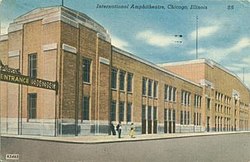International Amphitheater
 |
|
| Location | 4220 South Halsted Street Chicago, Illinois 60609 |
|---|---|
| Owner | (until 1983) |
| Capacity | 9,000 |
| Construction | |
| Opened | 1934 |
| Closed | 1999 |
| Demolished | August 3, 1999 (began) |
| Construction cost | $1.5 million ($26.9 million in 2017 dollars) |
| Tenants | |
|
Chicago Packers (NBA) (1961–62) Chicago Bulls (NBA) (1966–67) Chicago Cougars (WHA) (1972–75) Chicago Sting (NASL) (1976) |
|
The International Amphitheatre was an indoor arena located in Chicago, Illinois, between 1934 and 1999. It was located on the west side of Halsted Street, at 42nd Street, on the city's south side, adjacent to the .
The arena was built for $1.5 million, by the stock yard company, principally to host the International Livestock Exhibition. The arena replaced Dexter Park, a horse-racing track that had stood on the site for over 50 years prior to its destruction by fire in May 1934. The completion of the Amphitheatre ushered in an era where Chicago reigned as a convention capital. In an era before air conditioning and space for the press and broadcast media were commonplace, the International Amphitheatre was among the first arenas to be equipped with these innovations.
The arena, which seated 9,000, was the first home of the Chicago Packers of the NBA during 1961–62, before changing their name to the Chicago Zephyrs and moving to the Chicago Coliseum for their second season. It was also the home of the Chicago Bulls during their inaugural season of 1966–67; they also played only one game in the Chicago Coliseum, a playoff game in their first season, as no other arena was available for a game versus the St. Louis Hawks. Afterwards, the Bulls then moved permanently to Chicago Stadium.
The Amphitheatre was also the primary home of the Chicago Cougars of the WHA from 1972–1975. It was originally intended to be only a temporary home for the Cougars, but the permanent solution, the Rosemont Horizon, was not completed until 1980, five years after the team folded and a year after the WHA ceased operation. The International Amphitheatre was the home for Chicago's wrestling scene for years as well as the Chicago Auto Show for approximately 20 years beginning in the 1940s.
...
Wikipedia
